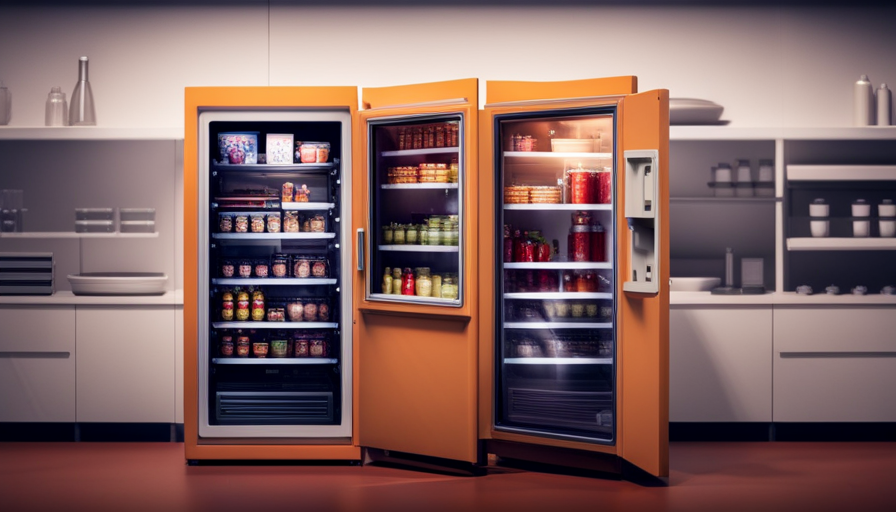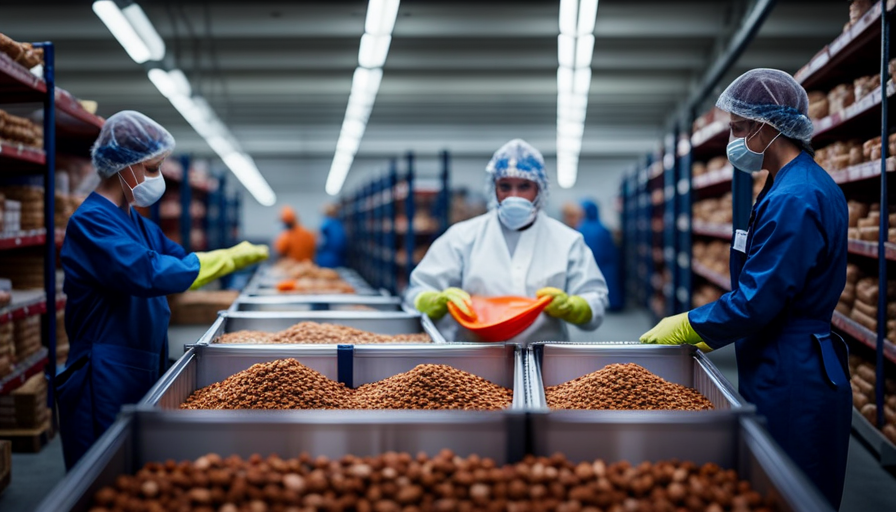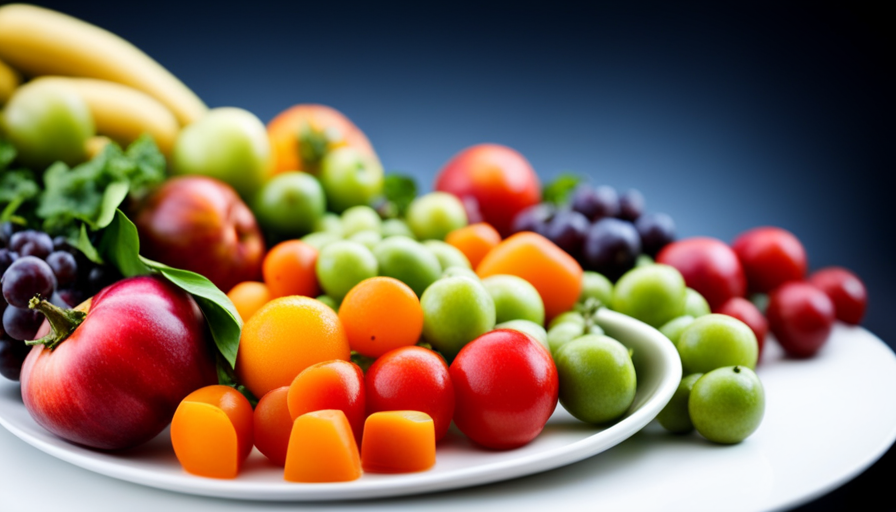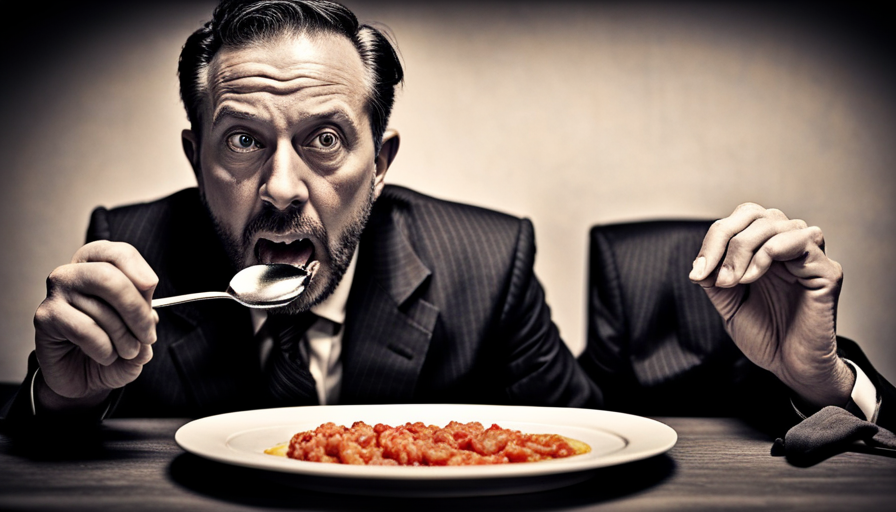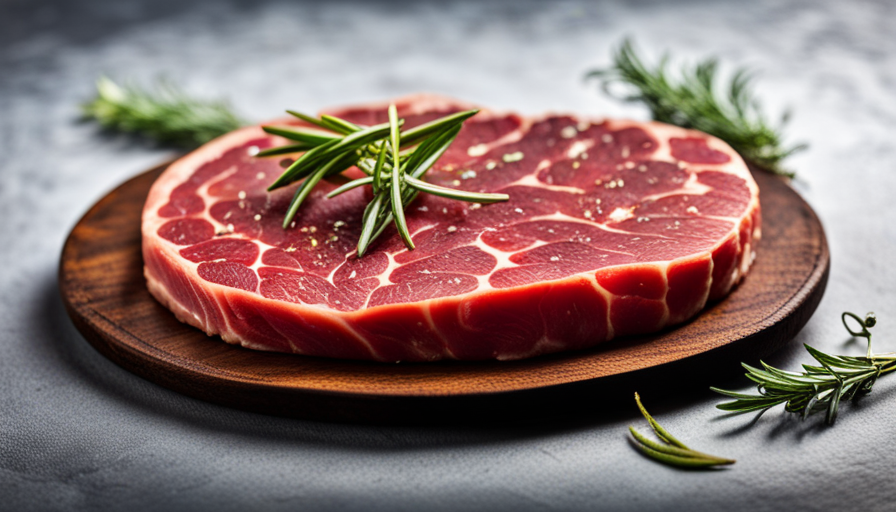Have you ever thought about how long raw chicken can be stored in the refrigerator? Keeping track of food expiration dates is key to maintaining a safe and healthy kitchen.
As a food safety enthusiast, I understand the importance of proper storage and handling techniques to prevent foodborne illnesses. So, let’s dive into the world of raw chicken storage and discover the optimal timeframe for keeping it in the fridge.
According to food safety guidelines, raw chicken can be stored in the refrigerator for a limited period. It’s essential to know the signs of spoiled chicken and the best practices for packaging and labeling.
Additionally, we’ll explore creative ways to use leftover chicken and the benefits of freezing it for future use. By following these tips, you can minimize food waste and ensure that your chicken is safe to eat.
So, let’s get started on this journey of proper food storage and discover the optimal lifespan of raw chicken in the fridge.
Key Takeaways
- Raw chicken should be stored in the refrigerator at or below 40°F (4°C).
- The safe storage duration for raw chicken in the fridge is 1-2 days before cooking or freezing.
- Signs of spoiled chicken include a foul odor, color/texture change, and the presence of slime or mold.
- Proper packaging and labeling are important for maintaining food safety, including using leak-proof containers and labels with the packaging date, use-by/sell-by date, and storage instructions.
The Importance of Proper Food Storage
Proper food storage is crucial to ensure the freshness and safety of your meals, including the length of time raw chicken can stay in the fridge. By following food storage tips, you can prevent the growth of harmful bacteria that can cause foodborne illnesses.
To start, it’s important to store raw chicken in a refrigerator set at or below 40°F (4°C). This temperature slows down the growth of bacteria, keeping the chicken fresh for longer.
When storing raw chicken, it’s essential to keep it in its original packaging or place it in a leak-proof container to prevent cross-contamination with other foods. Placing the chicken on a tray or in a shallow pan can also prevent any juices from dripping onto other items in the fridge.
According to the United States Department of Agriculture (USDA), raw chicken can be safely stored in the refrigerator for one to two days before it should be cooked or frozen. It’s not recommended to keep raw chicken in the fridge for longer than two days, as the risk of bacterial growth increases over time.
Understanding food safety guidelines is crucial for preventing foodborne illnesses. By following proper food storage practices, you can ensure the freshness and safety of your meals.
Understanding Food Safety Guidelines
To ensure the safety of your meals, it’s crucial to be mindful of the guidelines for handling and storing poultry in the refrigerator. Understanding food safety guidelines is essential in preventing foodborne illnesses and avoiding cross-contamination. Here are some key points to keep in mind:
-
Always store raw chicken in a sealed container or wrap it securely in plastic wrap to prevent its juices from coming into contact with other foods. This will help reduce the risk of cross-contamination.
-
Place raw chicken on the bottom shelf of the refrigerator to prevent any drippings from contaminating other foods.
-
If possible, use a separate drawer or compartment specifically designated for raw poultry to further minimize the risk of cross-contamination.
-
Keep raw chicken away from other ready-to-eat foods, such as fruits or vegetables, to prevent any potential transfer of harmful bacteria.
Following these guidelines will help keep your food safe and reduce the risk of foodborne illnesses.
Now, let’s move on to the next section to learn about how long raw chicken can be stored in the fridge.
How Long Can Raw Chicken Be Stored in the Fridge?
Storing poultry in the refrigerator requires careful attention to ensure it remains fresh and safe for consumption. When it comes to raw chicken, it is important to know the proper storage duration to prevent any risk of foodborne illnesses.
According to food safety guidelines, raw chicken can be stored in the fridge for up to 1-2 days. This timeframe ensures that the chicken stays within a safe temperature range of 40°F (4°C) or below, which slows down bacterial growth. It’s crucial to handle raw chicken properly during storage. This includes keeping it in a leak-proof container or sealed plastic bag to prevent cross-contamination with other foods. Additionally, placing the chicken on a tray or in a shallow pan can help catch any potential drips and further reduce the risk of contamination.
It’s important to note that these guidelines may vary depending on the specific type of chicken and the freshness at the time of purchase. Understanding safe handling practices and adhering to storage duration recommendations are key to ensuring the quality and safety of raw chicken.
Transitioning to the next section about signs of spoiled chicken, it’s crucial to be able to identify these indicators to avoid consuming potentially harmful food.
Signs of Spoiled Chicken
One telltale sign that your poultry may have gone bad is a foul odor emanating from the meat. Spoiled chicken has a distinct and unpleasant smell that is hard to miss. It is important to be aware of this odor and immediately discard any chicken that smells off.
In addition to the smell, there are other signs to look out for when determining if your chicken has spoiled. These include a change in color, texture, and the presence of slime or mold on the surface of the meat.
To ensure food safety, it’s crucial to follow proper storage guidelines for raw chicken. Keep the chicken refrigerated at a temperature below 40°F (4°C) to slow down bacterial growth. Store the chicken in its original packaging or place it in a leak-proof container to prevent cross-contamination. It’s also recommended to place the chicken on a lower shelf in the fridge to prevent any juices from dripping onto other foods.
Proper packaging and labeling play a crucial role in maintaining food safety. Make sure to label the chicken with the date of purchase and use it within the recommended timeframe. By following these guidelines, you can minimize the risk of consuming spoiled chicken and ensure the safety of your meals.
Proper Packaging and Labeling
Proper packaging and labeling are like the guardians of food safety, ensuring that your meals are protected and enjoyed without any worries. In the case of raw chicken, packaging regulations play a crucial role in preventing contamination and spoilage. It’s important to follow these regulations to maintain the quality and safety of the chicken.
The packaging should be leak-proof and sturdy, preventing any potential cross-contamination with other foods. Additionally, it should be properly sealed to prevent the entry of bacteria or air, which can lead to spoilage.
Labeling requirements are equally important when it comes to raw chicken. The label should include important information such as the date of packaging, use-by or sell-by date, and storage instructions. This helps consumers make informed decisions about the freshness and safety of the chicken. It also assists in proper rotation of stock in grocery stores and restaurants, ensuring that older products are used first.
Following packaging regulations and labeling requirements is essential in maintaining the quality and safety of raw chicken. By ensuring proper packaging and labeling, we can minimize the risk of contamination and spoilage. Now that we understand the importance of proper packaging and labeling, let’s move on to discussing safe thawing methods for raw chicken.
Safe Thawing Methods
To ensure a delightful and worry-free culinary experience, it’s essential to know the safe methods for thawing your delicious poultry. When it comes to thawing raw chicken, it’s crucial to prioritize food safety and prevent cross-contamination.
Safe thawing techniques involve three main methods: refrigerator thawing, cold water thawing, and microwave thawing.
Refrigerator thawing is the safest method as it allows the chicken to thaw at a controlled temperature. Simply place the chicken in a leak-proof plastic bag and let it thaw in the refrigerator for several hours or overnight.
Cold water thawing is a quicker method that involves placing the chicken in a sealed plastic bag and submerging it in cold water. It’s important to change the water every 30 minutes to maintain a safe temperature.
Microwave thawing is the fastest method but requires caution to ensure even thawing and prevent partial cooking.
By following these safe thawing techniques, you can prevent the growth of harmful bacteria and ensure that your raw chicken is thawed properly. This sets the stage for the subsequent section on best practices for handling raw chicken, where we will explore techniques for proper cleaning, cutting, and cooking.
Best Practices for Handling Raw Chicken
Ready to dive into the best ways to handle your juicy chicken? Let’s explore some expert tips and tricks to ensure your cooking experience is both safe and delicious!
When it comes to safe handling of raw chicken, there are a few important practices to keep in mind. First and foremost, always wash your hands thoroughly with soap and warm water before and after handling chicken. This helps to prevent the spread of harmful bacteria.
Additionally, make sure to use separate cutting boards and utensils for raw chicken to avoid cross-contamination.
When it comes to cooking techniques, it’s essential to cook chicken to a safe internal temperature of 165°F (74°C) to kill any bacteria that may be present. Using a food thermometer is the best way to ensure accuracy. Avoid partially cooking chicken and then refrigerating it, as this can promote bacterial growth.
If you’re marinating chicken, be sure to do so in the refrigerator, and discard any leftover marinade that has come into contact with raw chicken.
Now that you know the best practices for handling raw chicken, let’s move on to some creative ways to use leftover chicken.
Creative Ways to Use Leftover Chicken
Feeling adventurous? Let’s explore some fun and inventive ways to repurpose that leftover bird from last night’s feast! Here are some delicious leftover chicken recipes that’ll make your taste buds sing:
-
Chicken Enchiladas: Roll up shredded chicken in tortillas, smother ’em with enchilada sauce, and bake for a cheesy, flavorful meal.
-
Chicken Salad: Mix diced chicken with mayo, celery, and seasonings for a refreshing and protein-packed salad.
-
Chicken Quesadillas: Layer leftover chicken with cheese and veggies between tortillas, then cook until golden and melty.
-
Chicken Fried Rice: Sauté leftover chicken with rice, veggies, and soy sauce for a quick and satisfying dinner.
-
Chicken Pot Pie: Combine leftover chicken with veggies and a creamy sauce, then top with a flaky pastry crust for a comforting classic.
These recipes not only help prevent food waste but also provide a variety of flavors to keep your meals exciting. Don’t forget about freezing any leftover chicken that you can’t use immediately. Freezing preserves the freshness and quality of the chicken, ensuring you’ve got a handy protein source for future meals. So get creative with your leftovers and enjoy the delicious possibilities!
Don’t Forget About Freezing
When it comes to leftover chicken, freezing is a great way to preserve it for future use. However, it’s important to follow proper freezing guidelines to maintain the quality and safety of the chicken.
Additionally, when it comes time to defrost the frozen chicken, it’s crucial to do so properly to prevent the growth of harmful bacteria.
Freezing Guidelines
To properly preserve the quality and taste of raw chicken, you should freeze it within 1-2 days to ensure a mouthwatering meal later on. Freezing techniques are crucial in preventing freezer burn, which can negatively impact the texture and flavor of the chicken.
When freezing raw chicken, it’s important to remove as much air as possible from the packaging to avoid freezer burn. Vacuum-sealed bags or airtight containers are ideal for this purpose. Additionally, labeling the packaging with the date of freezing can help you keep track of how long the chicken has been in the freezer.
Properly defrosting frozen chicken is the next step in preparing a delicious dish, and I’ll guide you through it in the subsequent section.
Properly Defrosting Frozen Chicken
Ready to enjoy a mouthwatering meal? Let me guide you through the proper way to defrost your frozen chicken.
When it comes to defrosting chicken, it’s essential to use safe methods to prevent cross-contamination and ensure the chicken remains safe to consume. The best and safest way to defrost frozen chicken is to place it in the refrigerator. This method allows for a slow and controlled thaw, minimizing the risk of bacterial growth.
It’s important to note that defrosting chicken at room temperature or under running water isn’t recommended as it can promote the growth of harmful bacteria. By following safe defrosting methods, you can ensure that your chicken is properly thawed and ready to be cooked.
Now, let’s move on to the next section about tips for minimizing food waste.
Tips for Minimizing Food Waste
If you want to minimize food waste, one way is to be mindful of how long raw chicken is kept in the fridge. For example, if you leave raw chicken in the fridge for more than three days, it’s recommended to discard it to ensure safety and prevent foodborne illnesses.
Properly handling and storing raw chicken can help minimize waste and reduce the chances of leftover chicken going bad. Here are some tips for minimizing food waste when it comes to raw chicken:
-
Plan your meals: By planning your meals ahead of time, you can ensure that you use up the raw chicken before it goes bad. This reduces the chances of leftovers being wasted.
-
Proper storage: Store raw chicken in airtight containers or resealable bags to prevent cross-contamination and to keep it fresh for longer. Place it on the bottom shelf of the fridge to avoid any potential drips onto other foods.
-
Freeze leftovers: If you have leftover cooked chicken, freezing it in portion-sized containers can extend its shelf life and reduce waste. Just make sure to label and date the containers for easy identification.
By following these tips, you can minimize food waste, reduce leftovers, and ensure the safety of your meals.
Frequently Asked Questions
Can raw chicken be stored in the fridge for longer than the recommended time?
Yes, raw chicken can be stored in the fridge for longer than the recommended time. However, it’s important to ensure proper storage of raw chicken to maintain its quality and prevent foodborne illnesses. The recommended storage time for raw chicken in the fridge is 1-2 days. Beyond that, the risk of bacterial growth increases significantly. To extend the storage time, you can freeze raw chicken, which can be kept for up to 9-12 months in the freezer. Proper storage includes keeping it in a sealed container, at a temperature below 40°F (4°C), and away from other food items to prevent cross-contamination.
What are the potential health risks of consuming spoiled chicken?
The potential health risks of consuming spoiled chicken are significant. Spoiled chicken can contain harmful bacteria such as Salmonella and Campylobacter, which can cause food poisoning symptoms like nausea, vomiting, diarrhea, and abdominal cramps.
Other signs of spoiled chicken include a foul odor, slimy texture, and changes in color. It’s crucial to always discard chicken that shows any signs of spoilage to prevent the risk of foodborne illnesses.
How can I tell if raw chicken has gone bad?
To determine if raw chicken has gone bad, there are a few key signs to look out for. First, check for any changes in color or texture, such as a grayish tint or slimy feel.
Additionally, a strong, unpleasant odor is a clear indicator of spoilage. To prevent this, it’s crucial to properly store raw chicken in the fridge at a temperature below 40°F and separate it from other foods to prevent cross-contamination.
Are there any specific guidelines for packaging and labeling raw chicken?
When it comes to packaging and labeling raw chicken, there are specific guidelines and regulations that must be followed. These regulations ensure that the chicken is handled and stored properly to maintain its quality and safety.
Packaging regulations may include requirements for the type of container used, such as leak-proof and tamper-evident packaging. Proper labeling guidelines involve providing information such as the product name, expiration date, handling instructions, and any allergen warnings.
Adhering to these guidelines is crucial for maintaining food safety standards.
Can I safely thaw raw chicken at room temperature?
No, it’s not safe to thaw raw chicken at room temperature. Thawing chicken at room temperature can promote the growth of bacteria, increasing the risk of foodborne illnesses.
To thaw chicken safely, it’s recommended to use alternative methods such as thawing in the refrigerator, using cold water, or using the microwave. These methods help maintain the chicken at a safe temperature and prevent bacterial growth, ensuring the safety of the chicken for consumption.
Is Raw Chicken Safe to Eat If It’s Been in the Refrigerator for a Certain Amount of Time?
Raw chicken should not be consumed after it has been in the refrigerator for more than 1-2 days. Proper raw chicken refrigerator storage time is essential to prevent bacterial growth and foodborne illness. It’s crucial to follow food safety guidelines and use chicken within the recommended time frame to ensure it’s safe to eat.
Conclusion
In conclusion, it’s crucial to store raw chicken properly in the fridge to ensure food safety. By following food safety guidelines and understanding the recommended storage time, we can minimize the risk of foodborne illnesses.
However, it’s important to be aware of the signs of spoiled chicken, as consuming it can be harmful. Proper packaging, labeling, and handling techniques are also essential to maintain the quality of the chicken.
Additionally, freezing leftovers and taking steps to minimize food waste can help us make the most of our raw chicken.
Stay informed and keep your fridge organized for a healthy and delicious culinary experience.

